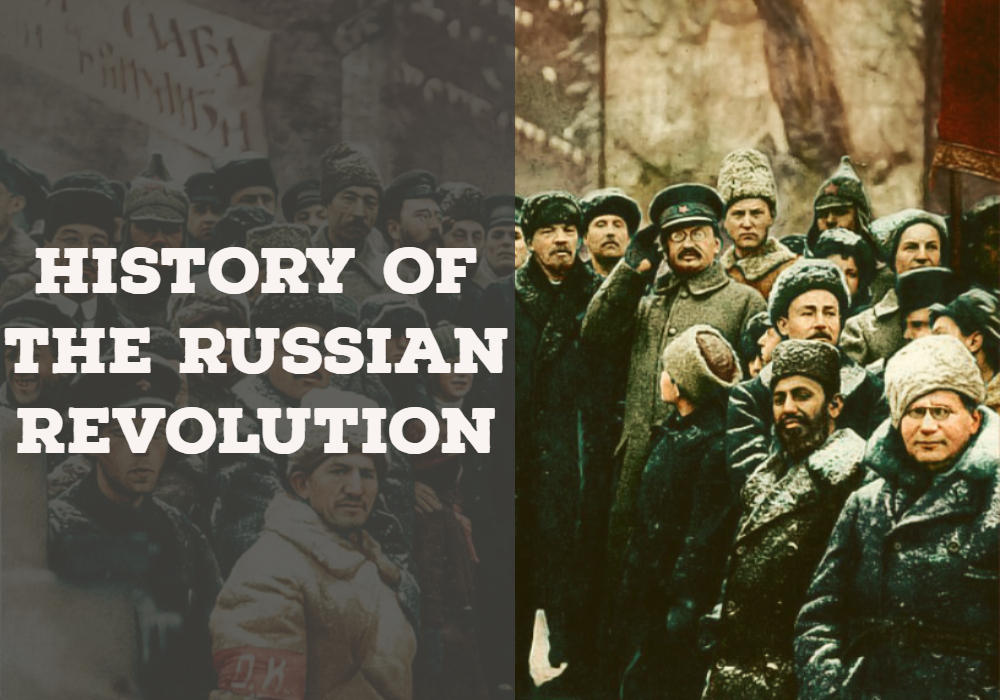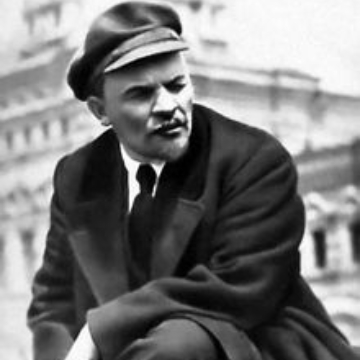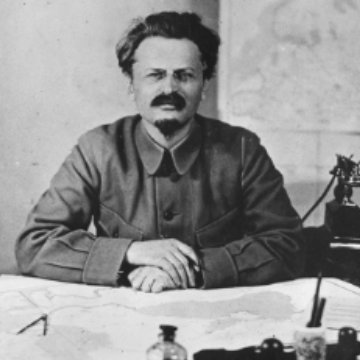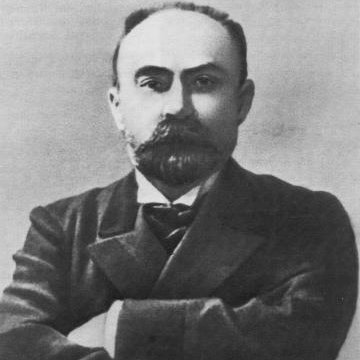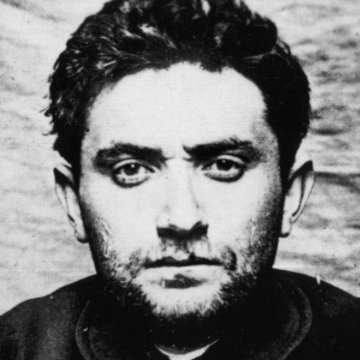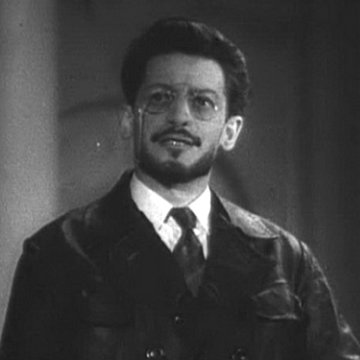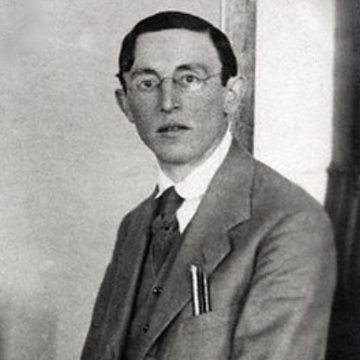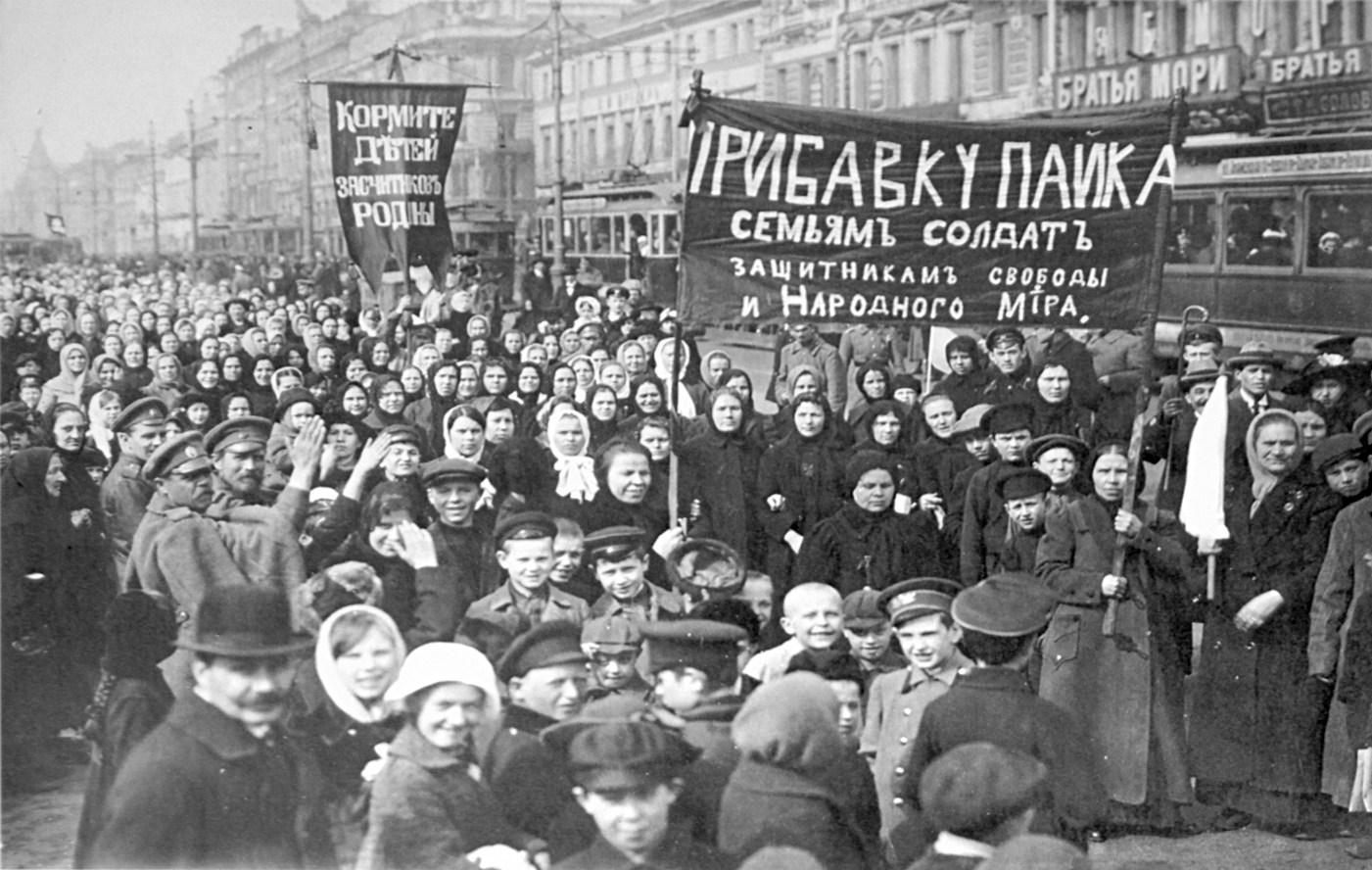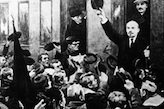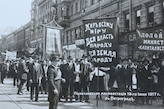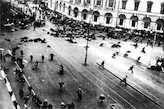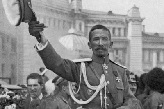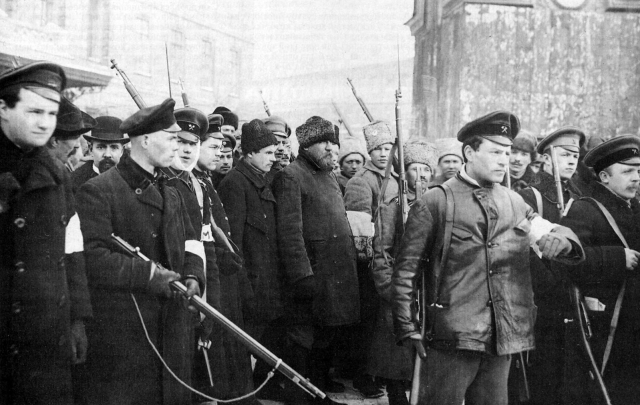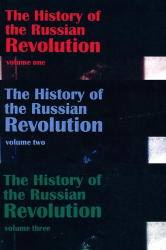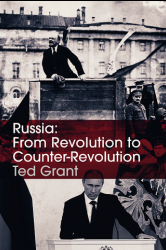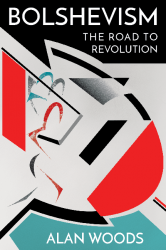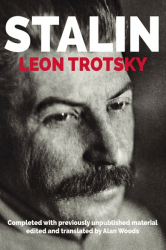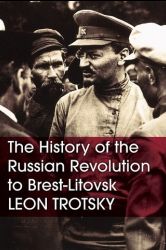During the first two months of 1917 Russia was still a Romanov monarchy. Eight months later the Bolsheviks stood at the helm. They were little know to anybody when the year began, and their leaders were still under indictment for state treason when they came to power. You will not find another such sharp turn in history – especially if you remember that it involves a nation of 150 million people. It is clear that the events of 1917, whatever you think of them, deserve study. Originally published 1930.
The history of a revolution, like every other history, ought first of all to tell what happened and how. That, however, is little enough. From the very telling it ought to become clear why it happened thus and not otherwise. Events can neither be regarded as a series of adventures, nor strung on the thread of a preconceived moral. They must obey their own laws. The discovery of these laws is the author’s task.
The most indubitable feature of a revolution is the direct interference of the masses in historical events. In ordinary times the state, be it monarchical or democratic, elevates itself above the nation, and history is made by specialists in that line of business - kings, ministers, bureaucrats, parliamentarians, journalists. But at those crucial moments when the old order becomes no longer endurable to the masses, they break over the barriers excluding them from the political arena, sweep aside their traditional representatives, and create by their own interference the initial groundwork for a new régime. Whether this is good or bad we leave to the judgement of moralists. We ourselves will take the facts as they are given by the objective course of development. The history of a revolution is for us first of all a history of the forcible entrance of the masses into the realm of rulership over their own destiny.
In a society that is seized by revolution classes are in conflict. It is perfectly clear, however, that the changes introduced between the beginning and the end of a revolution in the economic bases of the society and its social substratum of classes, are not sufficient to explain the course of the revolution itself, which can overthrow in a short interval age-old institutions, create new ones, and again overthrow them. The dynamic of revolutionary events is directly determined by swift, intense and passionate changes in the psychology of classes which have already formed themselves before the revolution.
The point is that society does not change its institutions as need arises, the way a mechanic changes his instruments. On the contrary, society actually takes the institutions which hang upon it as given once for all. For decades the oppositional criticism is nothing more than a safety valve for mass dissatisfaction, a condition of the stability of the social structure. Such in principle, for example, was the significance acquired by the social-democratic criticism. Entirely exceptional conditions, independent of the will of persons and parties, are necessary in order to tear off from discontent the fetters of conservatism, and bring the masses to insurrection.
The swift changes of mass views and moods in an epoch of revolution thus derive, not from the flexibility and mobility of man’s mind, but just the opposite, from its deep conservatism. The chronic lag of ideas and relations behind new objective conditions, right up to the moment when the latter crash over people in the form of a catastrophe, is what creates in a period of revolution that leaping movement of ideas and passions which seems to the police mind a mere result of the activities of “demagogues.”
The masses go into a revolution not with a prepared plan of social reconstruction, but with a sharp feeling that they cannot endure the old régime. Only the guiding layers of a class have a political program, and even this still requires the test of events, and the approval of the masses. The fundamental political process of the revolution thus consists in the gradual comprehension by a class of the problems arising from the social crisis – the active orientation of the masses by a method of successive approximations. The different stages of a revolutionary process, certified by a change of parties in which the more extreme always supersedes the less, express the growing pressure to the left of the masses – so long as the swing of the movement does not run into objective obstacles. When it does, there begins a reaction: disappointments of the different layers of the revolutionary class, growth of indifferentism, and therewith a strengthening of the position of the counter-revolutionary forces. Such, at least, is the general outline of the old revolutions.
Only on the basis of a study of political processes in the masses themselves, can we understand the rôle of parties and leaders, whom we least of all are inclined to ignore. They constitute not an independent, but nevertheless a very important, element in the process. Without a guiding organisation, the energy of the masses would dissipate like steam not enclosed in a piston-box. But nevertheless what moves things is not the piston or the box, but the steam.
The difficulties which stand in the way of studying the changes of mass consciousness in a revolutionary epoch are quite obvious. The oppressed classes make history in the factories, in the barracks, in the villages, on the streets of the cities. Moreover, they are least of all accustomed to write things down. Periods of high tension in social passions leave little room for contemplation and reflection. All the muses – even the plebeian muse of journalism, in spite of her sturdy hips – have hard sledding in times of revolution. Still the historian’s situation is by no means hopeless. The records are incomplete, scattered, accidental. But in the light of the events themselves these fragments often permit a guess as to the direction and rhythm of the hidden process. For better or worse, a revolutionary party bases its tactics upon a calculation of the changes of mass consciousness. The historic course of Bolshevism demonstrates that such a calculation, at least in its rough features, can be made. If it can be made by a revolutionary leader in the whirlpool of the struggle, why not by the historian afterwards?
However, the processes taking place in the consciousness of the masses are not unrelated and independent. No matter how the idealists and the eclectics rage, consciousness is nevertheless determined by conditions. In the historic conditions which formed Russia, her economy, her classes, her State, in the action upon her of other states, we ought to be able to find the premises both of the February revolution and of the October revolution which replaced it. Since the greatest enigma is the fact that a backward country was the first to place the proletariat in power, it behoves us to seek the solution of that enigma in the peculiarities of that backward country – that is, in its differences from other countries.
The historic peculiarities of Russia and their relative weight will be characterised by us in the early chapters of this book which give a short outline of the development of Russian society and its inner forces. We venture to hope that the inevitable schematism of these chapters will not repel the reader. In the further development of the book he will meet these same forces in living action.
This work will not rely in any degree upon personal recollections. The circumstance that the author was a participant in the events does not free him from the obligation to base his exposition upon historically verified documents. The author speaks of himself, in so far as that is demanded by the course of events, in the third person. And that is not a mere literary form: the subjective tone, inevitable in autobiographies or memoirs, is not permissible in a work of history.
However, the fact that the author did participate in the struggle naturally makes easier his understanding, not only of the psychology of the forces in action, both individual and collective, but also of the inner connection of events. This advantage will give positive results only if one condition is observed: that he does not rely upon the testimony of his own memory either in trivial details or in important matters, either in questions of fact or questions of motive and mood. The author believes that in so far as in him lies he has fulfilled this condition.
There remains the question of the political position of the author, who stands as a historian upon the same viewpoint upon which he stood as a participant in the events. The reader, of course, is not obliged to share the political views of the author, which the latter on his side has no reason to conceal. But the reader does have the right to demand that a historical work should not be the defence of a political position, but an internally well-founded portrayal of the actual process of the revolution. A historical work only then completely fulfils the mission when events unfold upon its pages in their full natural necessity.
For this, is it necessary to have the so-called historian’s “impartiality”? Nobody has yet clearly explained what this impartiality consists of. The often quoted words of Clemenceau that it is necessary to take a revolution “en bloc,” as a whole – are at the best a clever evasion. How can you take as a whole a thing whose essence consists in a split? Clemenceau’s aphorism was dictated partly by shame for his too resolute ancestors, partly by embarrassment before their shades.
One of the reactionary and therefore fashionable historians in contemporary France, L. Madelin, slandering in his drawing-room fashion the great revolution – that is, the birth of his own nation – asserts that “the historian ought to stand upon the wall of a threatened city, and behold at the same time the besiegers and the besieged”: only in this way, it seems, can he achieve a “conciliatory justice.” However, the words of Madelin himself testify that if he climbs out on the wall dividing the two camps, it is only in the character of a reconnoiterer for the reaction. It is well that he is concerned only with war camps of the past: in a time of revolution standing on the wall involves great danger. Moreover, in times of alarm the priests of “conciliatory justice” are usually found sitting on the inside of four walls waiting to see which side will win.
The serious and critical reader will not want a treacherous impartiality, which offers him a cup of conciliation with a well-settled poison of reactionary hate at the bottom, but a scientific conscientiousness, which for its sympathies and antipathies – open and undisguised – seeks support in an honest study of the facts, a determination of their real connections, an exposure of the causal laws of their movement. That is the only possible historic objectivism, and moreover it is amply sufficient, for it is verified and attested not by the good intentions of the historian, for which only he himself can vouch, but the natural laws revealed by him of the historic process itself.
The sources of this book are innumerable periodical publications, newspapers and journals, memoirs, reports, and other material, partly in manuscript, but the greater part published by the Institute of the History of the Revolution in Moscow and Leningrad. We have considered its superfluous to make reference in the text to particular publications, since that would only bother the reader. Among the books which have the character of collective historical works we have particularly used the two-volume Essays on the History of the October Revolution (Moscow-Leningrad, 1927). Written by different authors, the various parts of this book are unequal in value, but they contain at any rate abundant factual material.
The dates in our book are everywhere indicated according to the old style – that is, they are 13 days behind the international and the present Soviet calendar. The author felt obliged to use the calendar which was in use at the time of the revolution. It would have been no labour of course to translate the dates into the new style. But this operation in removing one difficulty would have created others more essential. The overthrow of the monarchy has gone into history as the February revolution; according to the Western calendar, however, it occurred in March. The armed demonstration against the imperialist policy of the Provisional Government has gone into history under the name of the “April Days,” whereas according to the Western calendar it happened in May. Not to mention other intervening events and dates, we remark only that the October revolution happened according to European reckoning in November. The calendar itself, we see, is tinted by the events, and the historian cannot handle revolutionary chronology by mere arithmetic. The reader will be kind enough to remember that before overthrowing the Byzantine calendar, the revolution had to overthrow the institutions that clung to it.
L. TROTSKY
Prinkipo
November 14, 1930
Source: Marxist Internet Archive

